1989 BMW M3 Evo 2 E30 road car vs. M3 Evo 2 racer E30
The BMW M3 grew from a sublime saloon to dominate Touring Car racing for five years. John Barker compares the road and track versions. Photography Jordan Butters.
COMPETITIVE ADVANTAGES
ROAD AND TRACK BMW M3 EVO 2
Proof of how racing improved the E30 breed
After six or seven gentle laps letting the oily bits of the M3 racer warm up and warm through, on the back straight I give the throttle a decent squeeze. The rev-counter needle heads past 4000rpm and finally the four-cylinder engine clears its throat. It’s pulling cleanly and loudly, its hard note reverberating around the bare cockpit like a jack hammer inside a cake tin.
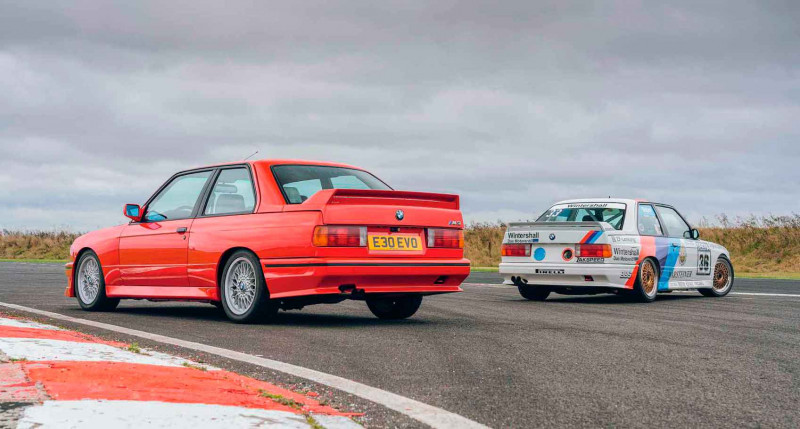
There’s still a lack of urgency, though, the guttural bark suggesting the engine is still digging deep, climbing the torque curve, not yet ‘on cam’. It’s surprising just how much further the revs have to rise before – at last – there’s a surge of power, a thrilling starburst of performance. And the M3 really starts moving.
It’s such a great looking competition car, the E30 M3: compact, taut, neat. When this example belonging to Richard Baxter rolls off the trailer and onto the asphalt at the Bedford Autodrome, I can’t keep the grin from my face. The way it sits, those split-rim alloys tucked up in the box ’arches, the instantly recognisable Warsteiner livery with corner-to-corner BMW Motorsport stripes…it’s just perfect. The comedian Billy Connolly was once recognised in the street by a fan who said: ‘Billy Connolly! You’re the spitting image of yourself!’ Well, this M3 racer is the absolute spit of itself.
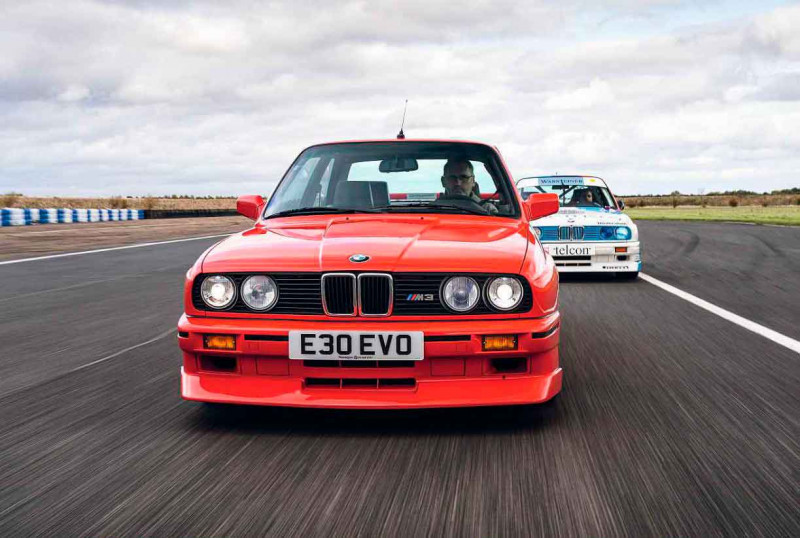
It looks just as it did in its first season back in 1989, right down to the name on the driver’s door: Steve Soper. Surrey-born Soper was the only Brit to earn a place in the works BMW driver squad, though it was only after Baxter had bought this car in 2005 that he got confirmation it really was Soper’s Zakspeed-run car. That makes it a double race-winner and one of only a handful of works-supported DTM (Deutsche Tourenwagen Meisterschaft) cars.
In ’1989 BMW was locked in combat with Ford and Mercedes. Ford had gone turbocharged with the Sierra RS Cosworth, while BMW had followed Mercedes’ lead with the 190E 2.3-16, tailoring the E30 M3 to the lower-capacity class of the new, Group A-based format, gambling that a lighter, more agile car would perform better. The four-cylinder E30 M3 was a big departure for BMW. The company had enjoyed much Touring Car success with six-cylinder cars such as the 635CSi but needed to sell 5000 units to homologate its next contender, which ruled out the M635CSi and its 24-valve straight-six. There were a couple of examples of the then-new E30 325i competing in the DTM but they trailed the ageing 635CSi E24, let alone the new Mercedes.
‘Carry speed into an inviting corner. Then, suddenly – remarkably – everything snaps into focus’
Mercedes doesn’t get nearly enough credit for creating the template for the E30M3. The E30 3-series and the 190E (W201) were both launched in 1982. Just a year later Mercedes revealed the 190E 2.3-16 W201, two years before BMW launched the M3. The Merc’s 2.3-litre engine had a 16-valve head developed by Cosworth and produced 185bhp when the Porsche 944’s 2.5-litre ‘four’ made 162bhp. BMW Motorsport was on the back foot. Its response was an even more bespoke car than the Merc, carrying over only the bonnet and sunroof of the regular E30. There were box ’arches for bigger wheels and wider tracks, a unique raised boot, rear screen angle and rear spoiler combo for improved aerodynamics, a faster steering rack, the five-stud hubs and brakes from the 5-series, a limited-slip diff and the same dog-leg, Getrag five-speed gearbox as the Mercedes. Its 2.3-litre S14 four-cylinder engine was pretty special, too, combining the M10 block (the basis of BMW’s 1300bhp, turbocharged F1 engine) and, in effect, the cylinder head of the E24 M635CSi’s 24-valve straight-six with two cylinders’ worth lopped off. In the road car it made 197bhp, shading the Merc’s output.
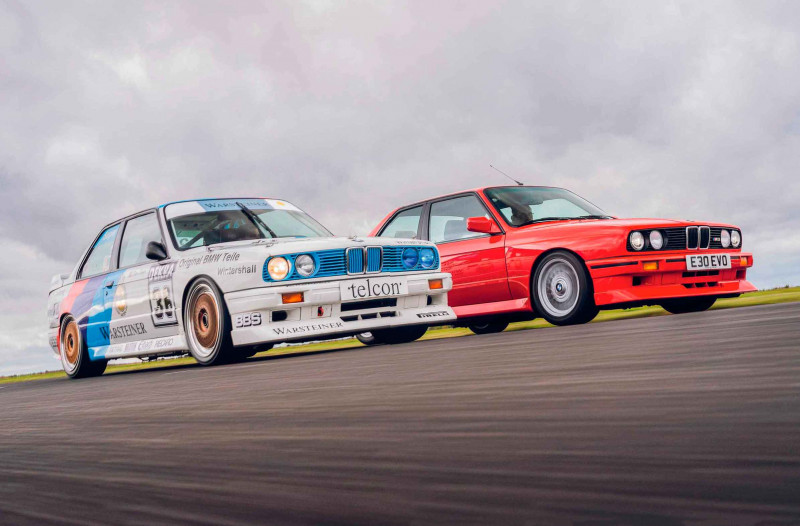
Mercedes had left privateer teams to campaign the 190E 2.3-16 in its first couple of DTM seasons, squandering its advantage. BMW Motorsport, on the other hand, had diligently developed a set of competition parts that would help the M3 win the DTM title in its debut season.
It wasn’t just the DTM, though. While Mercedes concentrated its efforts largely at home, BMW sent the M3 out into the wider world at a time when Touring Car regulations were remarkably well-aligned. When Mercedes finally won the DTM in ’92 and ’93 (with the wild-looking 190E 2.5-16 Evo II), the M3 was a global phenomenon. By then it had won (deep breath) the World Touring Car Championship, the European Touring Car Championship (twice), the Italian Superturismo Championship (four times), the Australian and British Touring Car championships, the Nürburgring 24 Hours (twice) and the Spa 24 Hours (four times). Oh, and the DTM, twice. In fact, it’s reckoned that the E30 M3 won a race for every day of its competition career – some 1650 wins in about 1600 days, from early ’87 to late ’92.
‘In utter contrast to the supple road car, the racer feels rock-hard. There is absolutely no slack’
The legendary status of the E30 M3 as a competition car is beyond question, then, and the road car that BMW Motorsport created to homologate it is solid gold as well: one of the finest driver’s cars of all time, in fact. Just don’t expect it to blow your socks off from the get-go.
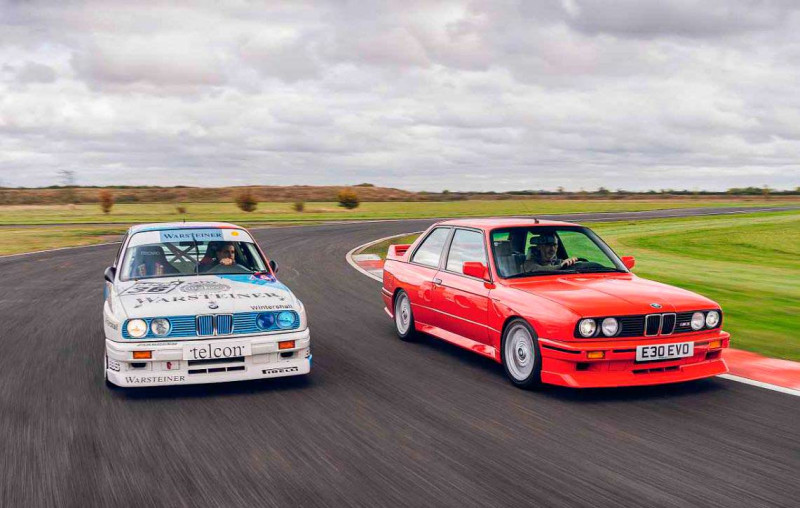
This pristine road car belonging to Silas Benaiah is a rare Evo 2. Evolutions to homologate new parts were permitted as long as at least 500 road car examples were built. The first M3 Evo featured little more than brake ducts instead of front foglamps but this Evo 2 incorporated lightweight glass and bodywork and a much-revised engine that lifted the road car’s outputs to 217bhp and 181lb ft of torque. It also brought a more pronounced front splitter and added an extra lip to the lower edge of the boot spoiler. And, having racer and road car side by side, what’s striking is that all the body add-ons are identical, probably interchangeable.
I’ve driven a few E30 M3 road cars over the years and every time I come to it my head is full of pin-sharp memories of its dynamic brilliance, small sequences I can replay in my head like TikTok videos, forgetting that it’s a slow burn. If it’s your first go, you might wonder if there’s something amiss because the engine makes a lot of noise but not much go. Still, the chassis is on point, right? Er… the steering feels unassisted and slow-witted and the ride is soft and cossetting where you’re probably expecting taut and edgy. Most current fast hatches have much more instant zing about them.
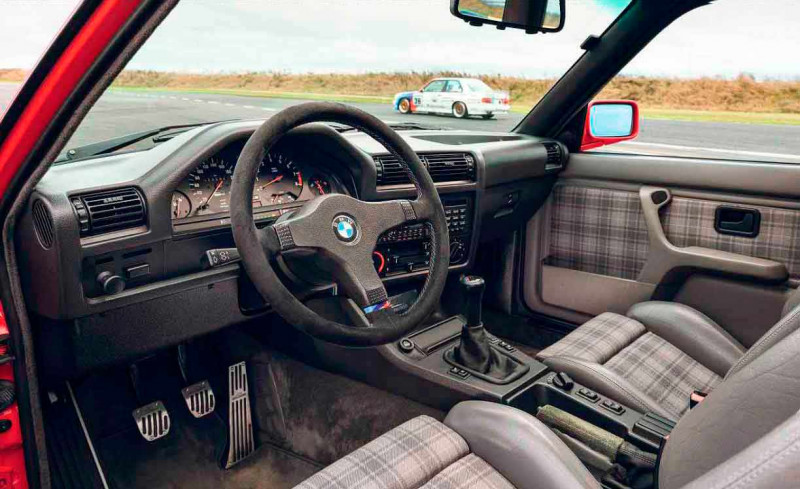
To reveal the magic you need to carry speed into an inviting corner. Then, suddenly – remarkably – everything snaps into focus: the steering is connected, accurate and talkative and the chassis beneath you becomes extraordinarily well-balanced and poised. The only thing that’s still missing is the torque to energise and exploit this dynamism, and that’s down to you.
So get busy with the light, snappy gearshift, appreciate the perfectly spaced ratios and keep the in-line four spinning happily up near the 7000rpm redline, where it sounds enthusiastic and delivers the power and torque the chassis deserves. Press the chassis harder and it just soaks up the pressure, and at some point you’ll find yourself coming into a corner waaay too fast. Don’t panic; it’s a rite of passage.
You’ll chuck the M3 at the corner in hope/desperation and, without breaking sweat, the M3 will settle into the apex with such ease, bothering neither the centre line nor the kerbside gravel, that you’ll pop out onto the straight with your jaw hanging loose, mind blown by its ability even on such modestly sized tyres.
It’s a fabulous car on track, too. Before he bought Soper’s racer in 2005, Baxter was using an M3 Sport Evo (also known as the Evo 3) for trackdays. He was enjoying it but finding it expensive to run, and M3 values had started to climb. He thought a racer would be more suitable and started looking. ‘This car had been up for sale for a long time,’ he says. ‘People weren’t interested because they are a lot harder to look after than road cars.’
It was up for £40k. Back then the seller, Alex Elliot, was buying up M3 race cars from around the world, paying as little as £6000 each. Baxter put down a hefty deposit and, as agreed, Elliot set about getting the car into shape.
By some estimates, 330 competition M3s were built, 270 Group A and 60 Group N, so it’s no surprise that quite a few have claimed to be ‘Soper’ cars. ‘I woke up one day and thought I could be buying a complete duff car here,’ recalls Baxter. ‘So I checked out the chassis number through a friend and he said “the period’s not right”. I really thought I was buying a dud. But then I thought, look, I like the car and it’s going to give me the experience I’m looking for. As I paid the final balance I got confirmation it was the right chassis number. Turns out I’d read the number wrong.’
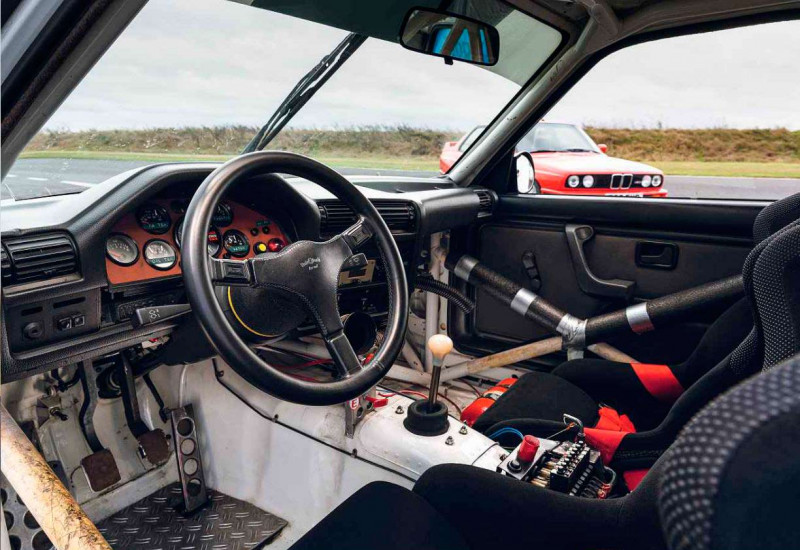
After taking delivery, and keen to confirm the car’s provenance, Baxter invited Soper to a trackday. He politely declined but did take up the offer of having the car on display at his dealership. As soon as he looked inside he knew it was his car. ‘Back then there was only one type of brake bias adjuster,’ says Soper, ‘but AP found me one with numbers. That was still in the car, so it is my old Zakspeed car. Or if it’s not, it’s a bloomin’ good copy!’
A works M3 racer is more durable but you have to be committed, says Baxter. ‘If you’re going on track you have to do a lot of preparation work, and you’ve got to trailer it. Then, when you get to the circuit, you’ve got a lot of preparation work to do again: wheel-tightening, tyre pressures and a spanner check. It all takes time. When I took it to the Nürburgring, over two days we managed something like 20 laps whereas in the road car we were doing 75. They were wonderful laps, though.’
Clamber over the cage with its crazed, yellowed, plastic wrap, drop into the bucket seat and you find yourself in a remarkably basic race-car interior. The standard facia and doorcards are still there, albeit cut about to fit around the roll cage, and there’s a gearlever, three pedals and a set of analogue dials with Dymo tape labels. Old school.
Flick the switches for the fuel pumps and they scream inside the naked cockpit with a harsh, metallic thrash. Push the start button and the starter motor cranks with a jangling, hollow ring and then one of the greatest in-line fours barks into life. It’s such a tight, clipped engine note but it’s immediately apparent that it’s in need of more revs, the huge valve overlaps that deliver its high-rev power leaving it gulping at a fast idle like a goldfish on the carpet.
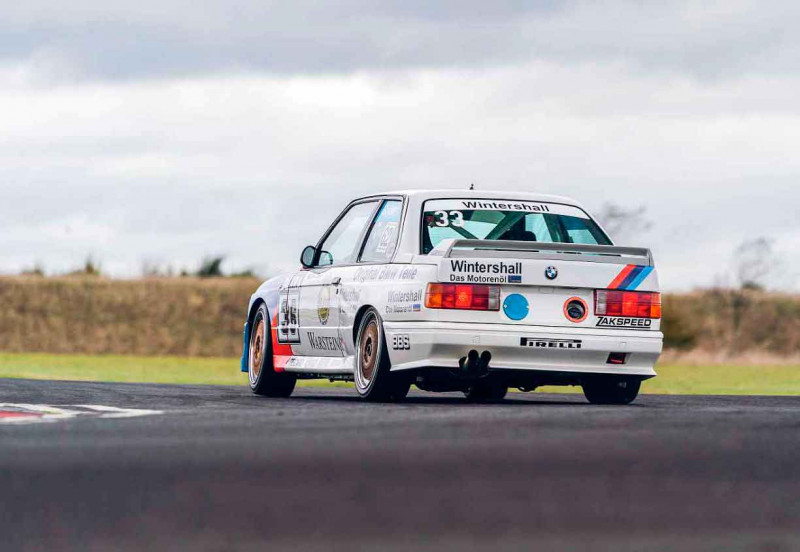
In utter contrast to the supple road car, the racer feels rock-hard. It’s a chilly day and we’re on wets to find a bit of grip but, from the start, the immediacy of the front end is startling. There is absolutely no slack: you turn the wheel a couple of degrees and the front darts for the apex. Until the rears get a little warmth in them the rear feels mobile but in a slow-moving, well-telegraphed way.
With the engine properly warmed and happily blaring at high revs, each gear dropping it back into the meat of the narrow powerband, the car feels focused, up on its toes. The rear is still a bit loose and the brake bias is dialled way too far to the back, so it’s squirrelly on the brakes and then easy to get the tail hanging out on the power, but there’s a taste of all the elements of the M3 racer coming together. Like the road car, you need to maintain momentum and keep it neat.
The first DTM M3s had 306bhp at 7800rpm but the Evo 2 had 316bhp at a stupendous 8500rpm. The reason there’s not much low-down – or even mid-range – shove is that peak torque is just 200lb ft at 7000rpm! That’s barely more than the road car manages.
Soper swapped a turbocharged Sierra with 550bhp for the M3 for the ’89 season, which must have been quite the shift. ‘It was a huge difference but the Ford didn’t put its power down very well,’ says Soper. ‘The M3 was very nimble and agile and handled much better. You had to keep the momentum up and you had to be nice and smooth with them. If you got lairy and spectacular it wasn’t quick.’
Soper was a works DTM M3 driver from ’89 to ’92 and rates his two wins at the new Nürburgring in this car in ’89 as his best. BMW Motorsport was supporting three works outfits: Schnitzer, Linder and Zakspeed, all on different tyres. ‘I don’t think anyone expected a Pirelli-shod me to win. Schnitzer were on Yokohamas, the more consistent tyre over a race distance. We won those races because Zakspeed was based at the Nürburgring, literally across the road. All our set-up work was done there. I was very tuned into the circuit.’
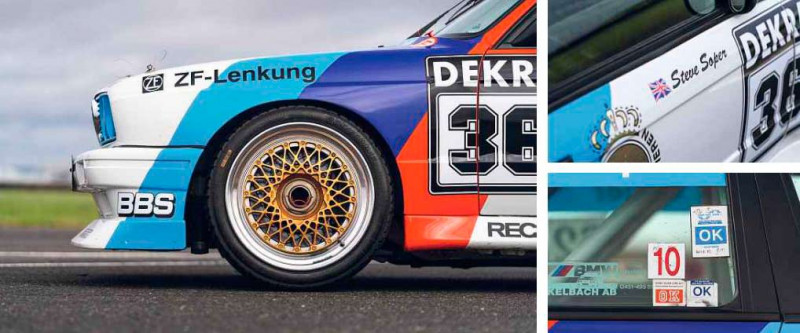
Baxter has traced the car’s history. At the end of ’89 it went to Sweden and raced in the domestic Touring Car championship for a few seasons. Then it was shipped to Malaysia and then on to the Philippines, but its engine went to Australia. Baxter’s car is running a later 2.5 bottom end, installed by a previous owner to make it more tractable for trackdays.
Engines didn’t stay with particular cars during the season; BMW Motorsport operated an engine exchange system whereby teams returned them at set intervals to be refreshed. Some think that Schnitzer got its pick of the engines but Soper doesn’t think so.
‘I don’t believe they did. We were all factory teams and we all got the same kit of bits. For sure, Schnitzer was the favourite team; they got better results. But, you know, it’s what you did with the bits. The cars were highly adjustable: roll centres, springs, dampers, anti-roll bars, ride heights, cambers. At the time, Schnitzer ran a better set-up, a better race team.’
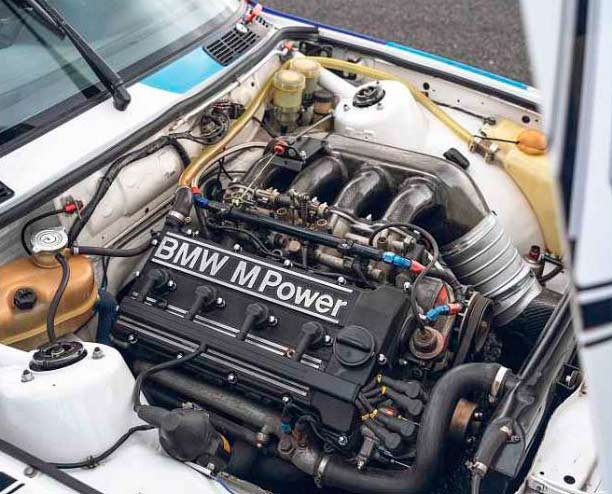
BMW was very good at winning championships, says Soper. He finished fifth in ’89 and Schnitzer took the title with Roberto Ravaglia. ‘It was very much a BMW team effort. It was a free-for-all for the first six races, something like that, and then who ever’d got the most points was regarded as team leader. In ’89, that was Ravaglia. The rest of us had to rally round and support. Basically, you weren’t allowed to beat him. If you were first and he was second you were expected to pull over. In my world that’s how it’s always been; we were paid a good salary to do a job for BMW.’
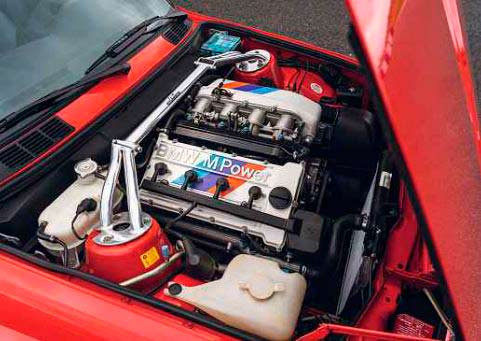
There will probably never be a Touring Car more successful than the E30 M3. It was superbly engineered, reliable and fast, made the most of the favourable alignment of regulations around the world, and was piloted by some of the world’s best drivers.
Oh, and the road car’s not bad, either.
‘There will probably never be a Touring Car more successful than the E30 M3’
Clockwise, from above You don’t have to drive a works M3 like this, but why wouldn’t you? Stripped interior has recognisable basics but is focused simply on driving; venerable four achieves peak power at a screaming 8500rpm!
Clockwise, from right Same engine in here as in the racer, though slightly less power; Evo 2 spoiler package interchangeable between road and race cars; road car is the more civilised within by far.
Technical data 1989 BMW E30 M3 Evo 2 road car
- Engine 2302cc DOHC four-cylinder, Bosch electronic fuel injection and engine management
- Max Power 217bhp @ 6750rpm
- Max Torque 181lb ft @ 4750rpm
- Transmission Five-speed manual, rear-wheel drive
- Steering Rack and pinion, power-assisted
- Suspension Front: MacPherson struts, lower wishbones, coil springs, anti-roll bar. Rear: semi-trailing arms, coil springs, telescopic dampers, anti-roll bar
- Brakes Discs, anti-lock
- Weight 1200kg
- Top speed 147mph
- 0-60mph 6.4sec
Technical data 1989 BMW E30 M3 Evo 2 racer
- Engine 2332cc DOHC four-cylinder, Bosch electronic fuel injection and engine management
- Max Power 316bhp @ 8500rpm
- Max Torque 200lb ft @ 7000rpm
- Transmission Five-speed manual, rear-wheel drive
- Steering Rack and pinion
- Suspension Front: MacPherson struts, lower wishbones, coil springs, anti-roll bar. Rear: trailing arms, coil springs, telescopic dampers, anti-roll bar
- Brakes Discs
- Weight 940kg (unladen), 1040kg (min class weight)
- Top speed 160mph (depends on gearing)
- 0-62mph 4.6sec
Above and left This works racer was piloted by none other than Touring Car legend Steve Soper; bodywork was highly modified in comparison to the regular E30.


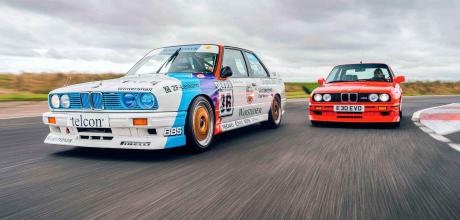
‘I’ve driven a few E30 M3s over the years but never got up close with its racing equivalent. BMW Motorsport created the most successful Touring Car of all time from what today seem to be quite simple ingredients; as with the brilliant road car, it’s all in the execution.’ BMW M3, road vs track
While it may seem a minor nit to pick, the first competitive outing for the glorious E30 M3 was in the divine black and gold JPS Team BMW livery, so splendidly displayed in your April spread on Pip Barker’s car, at Calder Park, Melbourne Australia on 28th February 1987. Jim Richards finished fifth before going on to win the championship – not the Monza WTCC round on 22nd March 1987 as stated in 50 Years of M – Part 2. Just to continue the theme, when the ex-JPS Team BMW cars sold to Peter Brock’s Mobil 05 team and then to Peter Doulman, they had 2-litre engines developed in Australia for the local Australian Super Touring championship. Their success saw BMW M obtaining the development work as the basis for the ETCC and WTCC cars.